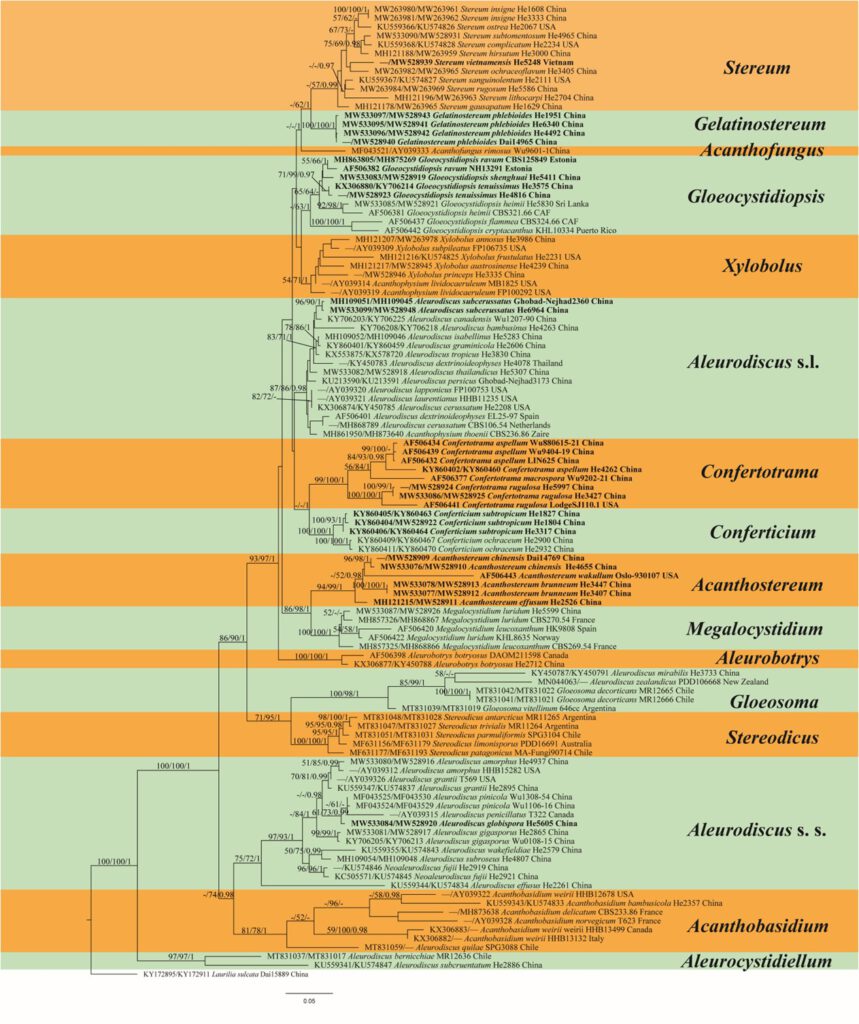Acanthostereum S.H. He & Nakasone, gen. nov.
MycoBank number: MB; Index Fungorum number: IF; Facesoffungi number: FoF 10779;
(Descriptions of sexual and asexual states of the genus)
Sexual state: Fruiting body – Basidiomata annual, resupinate to effused-reflexed, adnate, coriaceous to soft corky. Pilei small, usually curved inside after dry; abhymenial surface with dense tomentum when juvenile, becoming glabrous with age, grayish-brown to dark brown, sulcate and zonate. Hymenophore smooth to tuberculate, grayish-orange, light brown, grayish-brown, golden brown to brown, unchanged in KOH, uncracked or deeply cracked with age; margin thinning out, determinate, adnate or slightly elevated, paler than or concolorous with hymenophore. Microscopic structures – Hyphal system monomitic. Generative hyphae simple-septate, colorless to pale yellow, thick-walled, smooth, more or less parallel to substratre. Skeletocystidia or gloeocystidia present, tubular, vesicular or clavate with or without a papilla, colorless to yellow, thick-walled, smooth, mostly embedded. Acanthocystidia (Acanthophyses) present, subclavate to subcylindrical, colorless to pale yellow, thin- to thick-walled, with spines at the tip part, with a basal septum. Basidia clavate to subcylindrical, colorless, thin-walled, smooth, with four sterigmata and a basal septum. Basidiospores oblong ellipsoid to cylindrical, colorless, thin-walled, smooth, amyloid, acyanophilous. Asexual state: not observed.
Type species: Acanthostereum chinensis (Pilát) S.H. He & Nakasone.
Notes: Our phylogenetic analyses based on ITS-nrLSU sequences data indicated that S. peculiare, Megalocystidium wakullum and two undescribed species formed a strongly supported lineage sister to Megalocystidium s.s. and independent to Stereum s.s. in Stereaceae (Fig. 1). Morphologically, species in this lineage differs from Megalocystidium by having simple-septate generative hyphae and acanthophyses, and from Stereum by having large cylindrical basidiospores. Thus, we raise Stereum subgen. Acanthostereum to the generic level and apply it for this lineage.
Importance and role:
Importance of genus to humans or ecosystem Not found
Industrial relevance and applications Not found
Quarantine significance Not found
Biochemical importance of the genus, chemical diversity or applications Not found
Species list
Acanthostereum brunneum S.H. He & Y.F. Cao, sp. nov.
Acanthostereum chinensis (Pilát) S.H. He & Nakasone, comb. nov.
Acanthostereum effusum S.H. He & Y.F. Cao, sp. nov.
Acanthostereum wakullum (Burds., Nakasone & G.W. Freeman) S.H. He & Nakasone, comb. nov.
Phylogenetic placement of genus Acanthostereum

Fig. 1. Phylogenetic tree obtained from maximum parsimony analysis of ITS and nrLSU sequence data of Stereaceae. Branches are labelled with parsimony bootstrap values (≥ 50%, front), likelihood bootstrap values (≥ 50%, middle) and Bayesian posterior probabilities (≥ 0.95, back). New taxa are shown in bold.
Species
